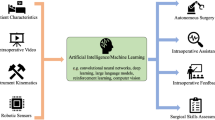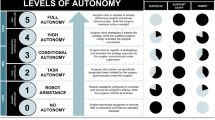Abstract
Operative repair of complex conditions such as esophageal atresia and tracheoesophageal fistula (EA/TEF) is technically demanding, but few training opportunities exist outside the operating theater for surgeons to attain these skills. Learning them during surgery on actual neonates where the stakes are high, margins for error narrow, and where outcomes are influenced by technical expertise, is problematic. There is an increasing demand for high-fidelity simulation that can objectively measure performance. We developed such a simulator to measure force and motion reliably, allowing quantitative feedback of technical skill. A 3D-printed simulator for thoracoscopic repair of EA/TEF was instrumented with motion and force tracking components. A 3D mouse, inertial measurement unit (IMU), and optical sensor that captured force and motion data in four degrees of freedom (DOF) were calibrated and verified for accuracy. The 3D mouse had low average relative errors of 2.81%, 3.15%, and 6.15% for 0 mm, 10 mm offset in Y, and 10 mm offset in X, respectively. This increased to − 23.5% at an offset of 42 mm. The optical sensors and IMU displayed high precision and accuracy with low SDs and average relative errors, respectively. These parameters can be a useful measurement of performance for thoracoscopic EA/TEF simulation prior to surgery.

Inclusion of sensors into a high-fidelity simulator design can produce quantitative feedback which can be used to objectively asses performance of a technically difficult procedure. As a result, more surgical training can be done prior to operating on actual patients in the operating theater.






Similar content being viewed by others
References
Holcomb GW 3rd et al (2005) Thoracoscopic repair of esophageal atresia and tracheoesophageal fistula: a multi-institutional analysis. Ann Surg. https://doi.org/10.1097/01.sla.0000179649.15576.db
Gause CD, Hsiung G, Schwab B, Clifton M, Harmon CM, Barsness KA (2016) Advances in pediatric surgical education: a critical appraisal of two consecutive minimally invasive pediatric surgery training courses. J Laparoendosc Adv Surg Tech A. https://doi.org/10.1089/lap.2016.0249
Sturm LP, Windsor JA, Cosman PH, Cregan PC, Hewett PJ, Maddern GJ (2008) A systematic review of surgical skills transfer after simulation-based training. Ann Surg. https://doi.org/10.1097/SLA.0b013e318176bf24
Salkini MW, Doarn CR, Kiehl N, Broderick TJ, Donovan JF, Gaitonde K (2010) The role of haptic feedback in laparoscopic training using the LapMentor II. J Endourol. https://doi.org/10.1089/end.2009.0307
Retrosi G, Cundy T, Haddad M, Clarke S (2015) Motion analysis–based skills training and assessment in pediatric laparoscopy: construct, concurrent, and content validity for the eoSim simulator. J Laparoendosc Adv Surg Tech A. https://doi.org/10.1089/lap.2015.0069
Nasr A, Carrillo B, Gerstle JT, Azzie G (2014) Motion analysis in the pediatric laparoscopic surgery (PLS) simulator: validation and potential use in teaching and assessing surgical skills. J Pediatr Surg. https://doi.org/10.1016/j.jpedsurg.2014.02.063
Harada K et al (2015) Quantitative pediatric surgical skill assessment using a rapid-prototyped chest model. Minim Invasive Ther Allied Technol. https://doi.org/10.3109/13645706.2014.996161
Van Sickle KR, McClusky DA, Gallagher AG, Smith CD (2005) Construct validation of the ProMIS simulator using a novel laparoscopic suturing task. Surg Endosc Other Interv Tech. https://doi.org/10.1007/s00464-004-8274-6
Rodrigues SP, Horeman T, Sam P, Dankelman J, Van Den Dobbelsteen JJ, Jansen FW (2014) Influence of visual force feedback on tissue handling in minimally invasive surgery. Br J Surg. https://doi.org/10.1002/bjs.9669
Gavrilovic B, Fahy A, Carrillo B, Nasr A, Gerstle JT, Azzie G (2018) Development of an open-source laparoscopic simulator capable of motion and force assessment: high tech at low cost. J Laparoendosc Adv Surg Tech A 28(10):1253-1260. https://doi.org/10.1089/lap.2018.0126
Horeman T, Rodrigues SP, Jansen FW, Dankelman J, Van Den Dobbelsteen JJ (2010) Force measurement platform for training and assessment of laparoscopic skills. Surg Endosc Other Interv Tech. https://doi.org/10.1007/s00464-010-1096-9
Trejos AL, Patel RV, Naish MD, and Schlachta CM 2008 Design of a sensorized instrument for skills assessment and training in minimally invasive surgery. In Proceedings of the 2nd Biennial IEEE/RAS-EMBS International Conference on Biomedical Robotics and Biomechatronics, BioRob, 2008
Azzie G et al (2011) Development and validation of a pediatric laparoscopic surgery simulator. J Pediatr Surg. https://doi.org/10.1016/j.jpedsurg.2011.02.026
Fedorov A et al (2012) 3D slicer as an image computing platform for the quantitative imaging network. Magn Reson Imaging. https://doi.org/10.1016/j.mri.2012.05.001
“Slicer” 2013. Available via https://www.slicer.org
“Blender” 2016. Available via http://www.blender.org
Spitz L (2007) Oesophageal atresia. Surgery 28(1):38–42
3DConnexion, “SpaceMouse® Wireless,” 2017. [Online]. Available: https://www.3dconnexion.com/spacemouse_wireless/en/. Accessed: 13-Nov-2017
V. Senft and Pascucci A 2011 Optoelectronic device for determining relative movements or relative positions of two objects
PixArt Imaging 2016 PMW3360DM-T2QU: Optical Gaming Navigation Sensor PixArt Imaging Inc., [Online]. Available: http://www.pixart.com/upload/PMS0058-PMW3360DM-T2QU-NNDS-R1.30-06042016_20160902201411.pdf
Bosch Sensortec 2014 BNO055 Intelligent 9-axis absolute orientation sensor. [Online]. Available: https://cdn-shop.adafruit.com/datasheets/BST_BNO055_DS000_12.pdf
adafruit, Adafruit BNO055 Absolute Orientation Sensor. learn.adafruit.com . [Online]. Available: https://learn.adafruit.com/adafruit-bno055-absolute-orientation-sensor. Accessed: 05-May-2018
Arduino 2016 Arduino – Reference. Lang Ref
Riverbank Computing Limited, “PyQt 5.11.2,” 2018. [Online]. Available: https://pypi.org/project/PyQt5/
Splitcam 8.1.4, 2018 [Online]. Available: http://splitcamera.com/download.html
Bradski G 2000 The OpenCV Library. Dr Dobbs J. Softw. Tools. https://doi.org/10.1111/0023-8333.50.s1.10
Bellard F 2018 ffmpeg 4.0.1. [Online]. Available: https://www.ffmpeg.org/
Liechti C 2017 pySerial 3.4. [Online]. Available: https://pypi.org/project/pyserial/. Accessed: 16-Mar-2018
Costa WL 2017 pyusb 1.0.2. [Online]. Available: https://pypi.org/project/pyusb/. Accessed: 21-Feb-2018
Hunter JD (2007) Matplotlib: a 2D graphics environment. Comput Sci Eng. https://doi.org/10.1109/MCSE.2007.55
NXP Semiconductors (2014) UM10204 I2C-bus specification and user manual. Semiconductors 3:64
Acknowledgements
We would like to acknowledge the generous advice and support given by Georges Azzie and Bojan Gavrilovic from Toronto Sick Kid’s Hospital and the University of Toronto.
Author information
Authors and Affiliations
Corresponding author
Additional information
Publisher’s note
Springer Nature remains neutral with regard to jurisdictional claims in published maps and institutional affiliations.
Rights and permissions
About this article
Cite this article
Moorhead, A.A., Nair, D., Morison, C. et al. Development of an instrumented thoracoscopic surgical trainer for objective evaluation of esophageal atresia/tracheoesophageal fistula repair. Med Biol Eng Comput 58, 601–609 (2020). https://doi.org/10.1007/s11517-019-02107-6
Received:
Accepted:
Published:
Issue Date:
DOI: https://doi.org/10.1007/s11517-019-02107-6




